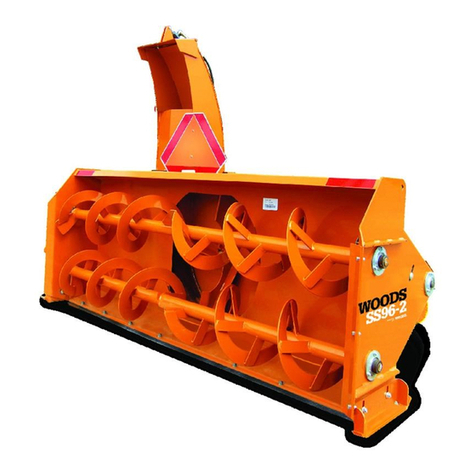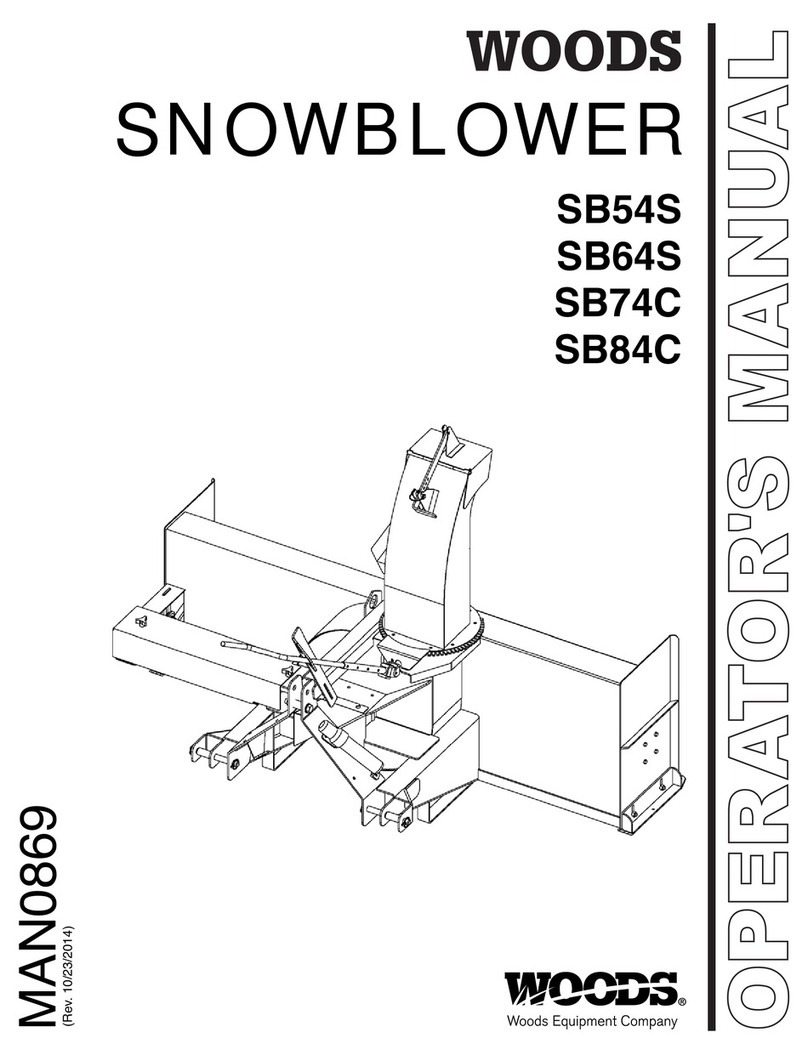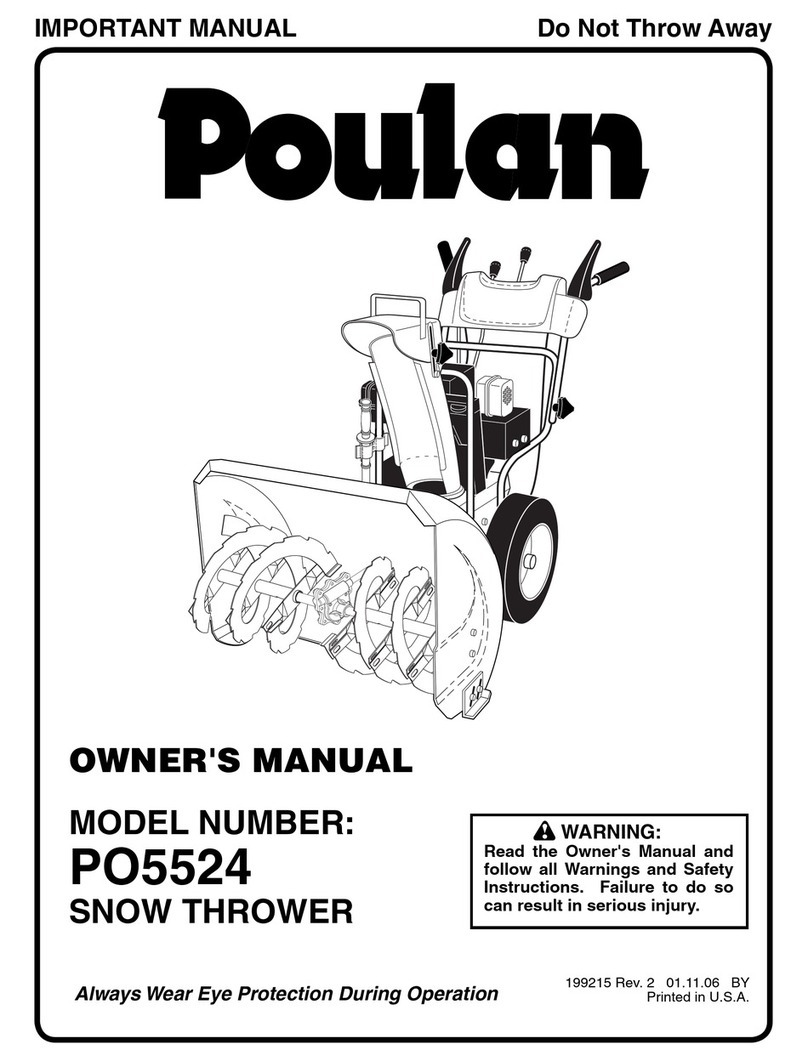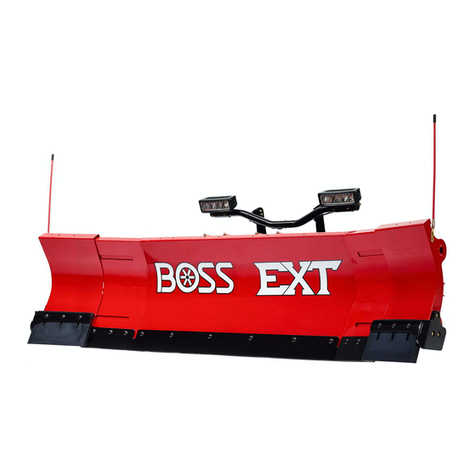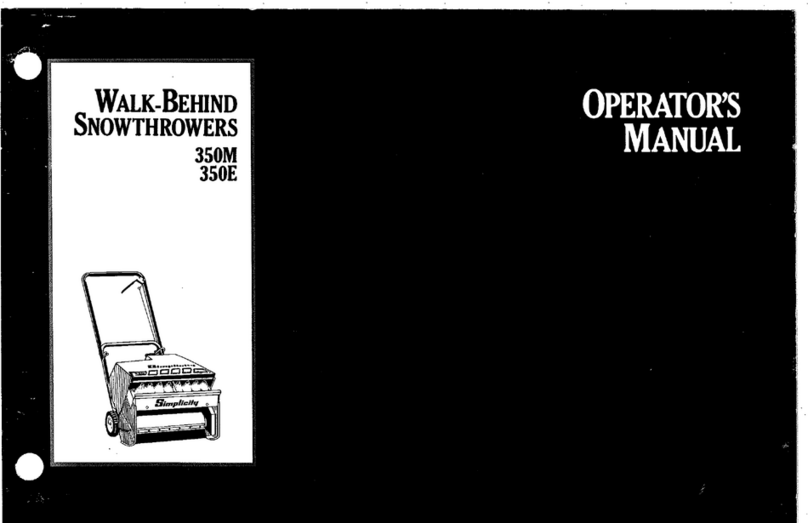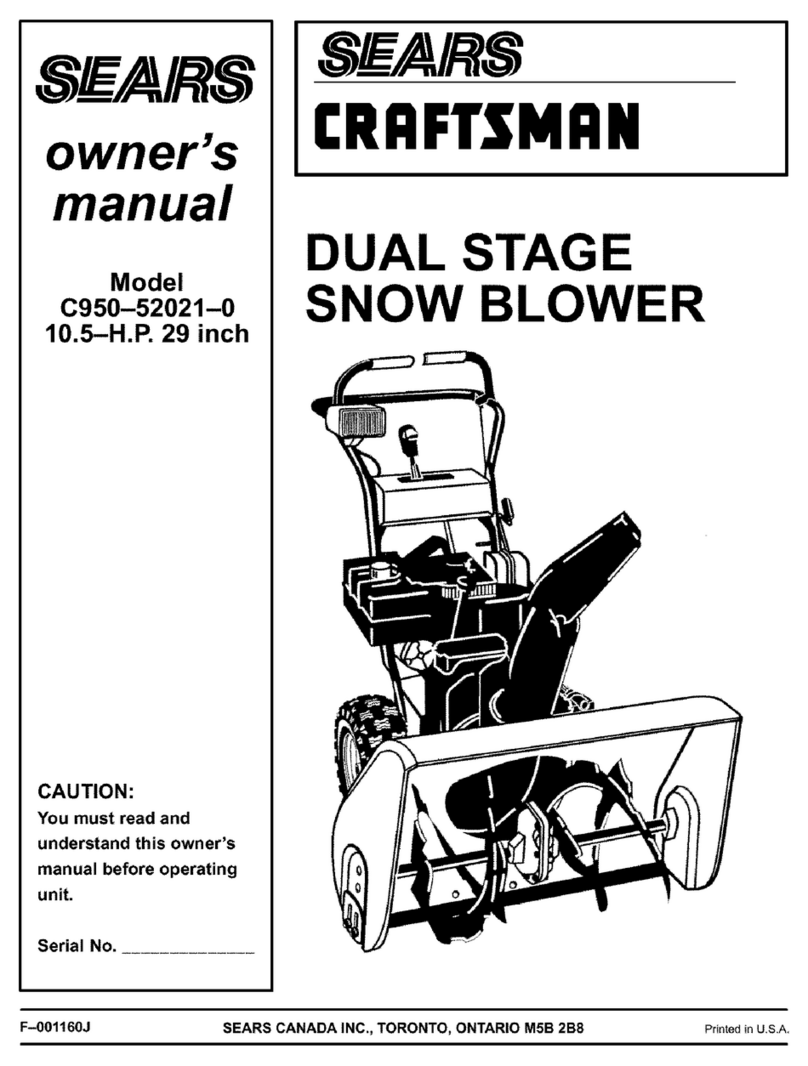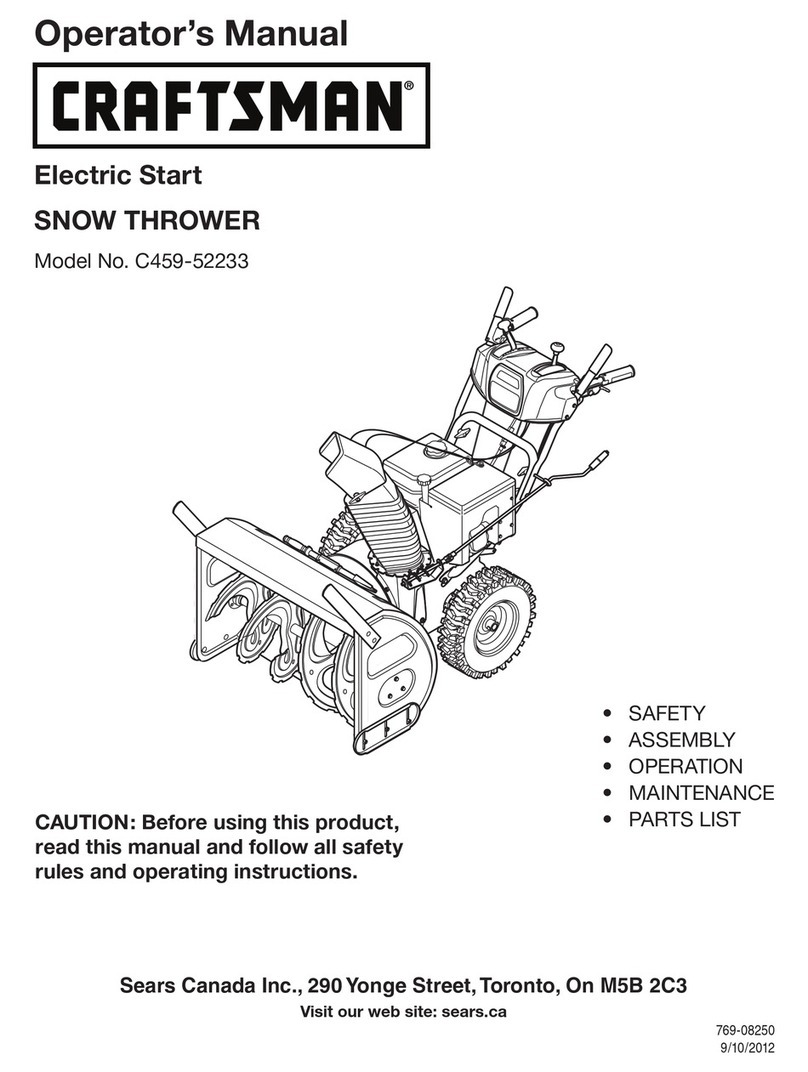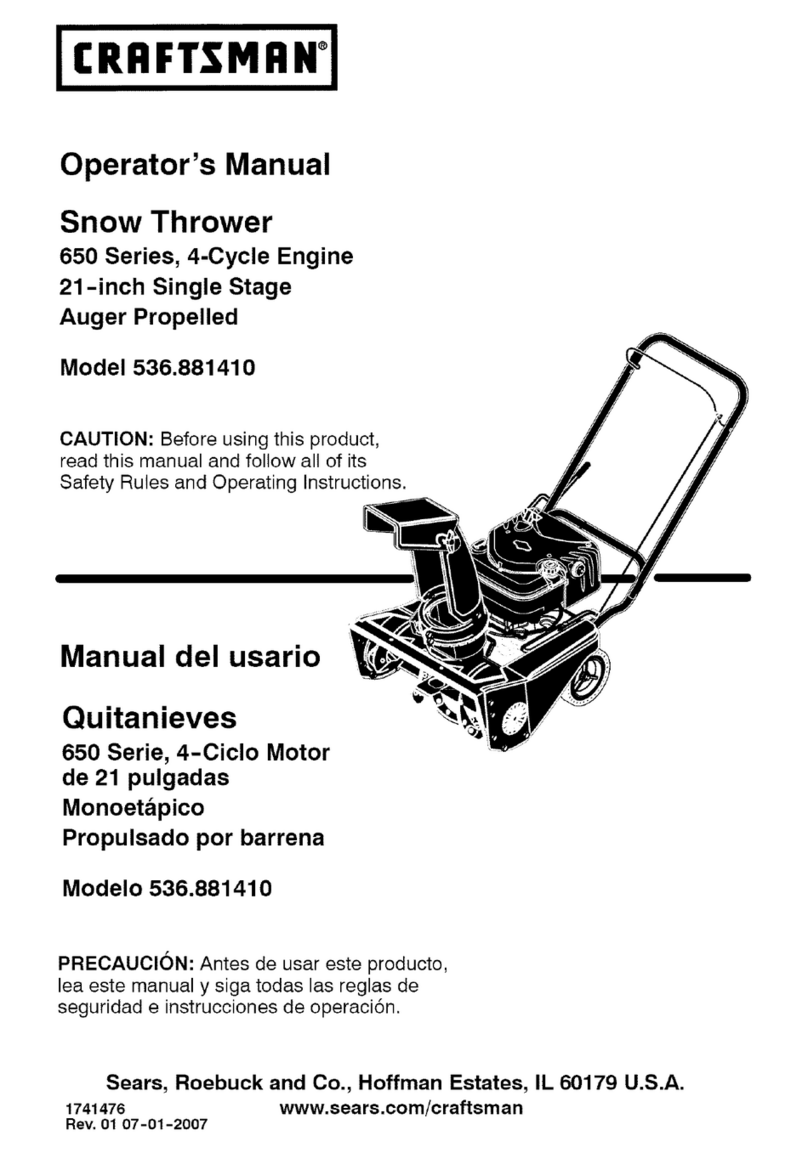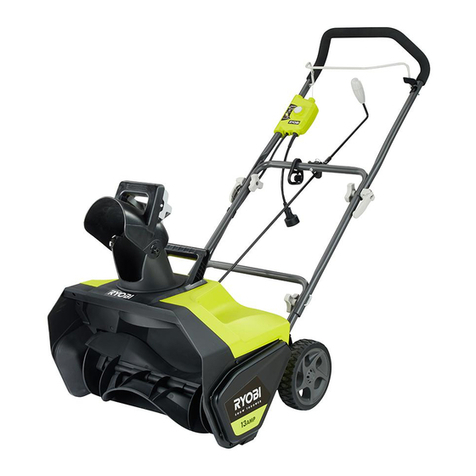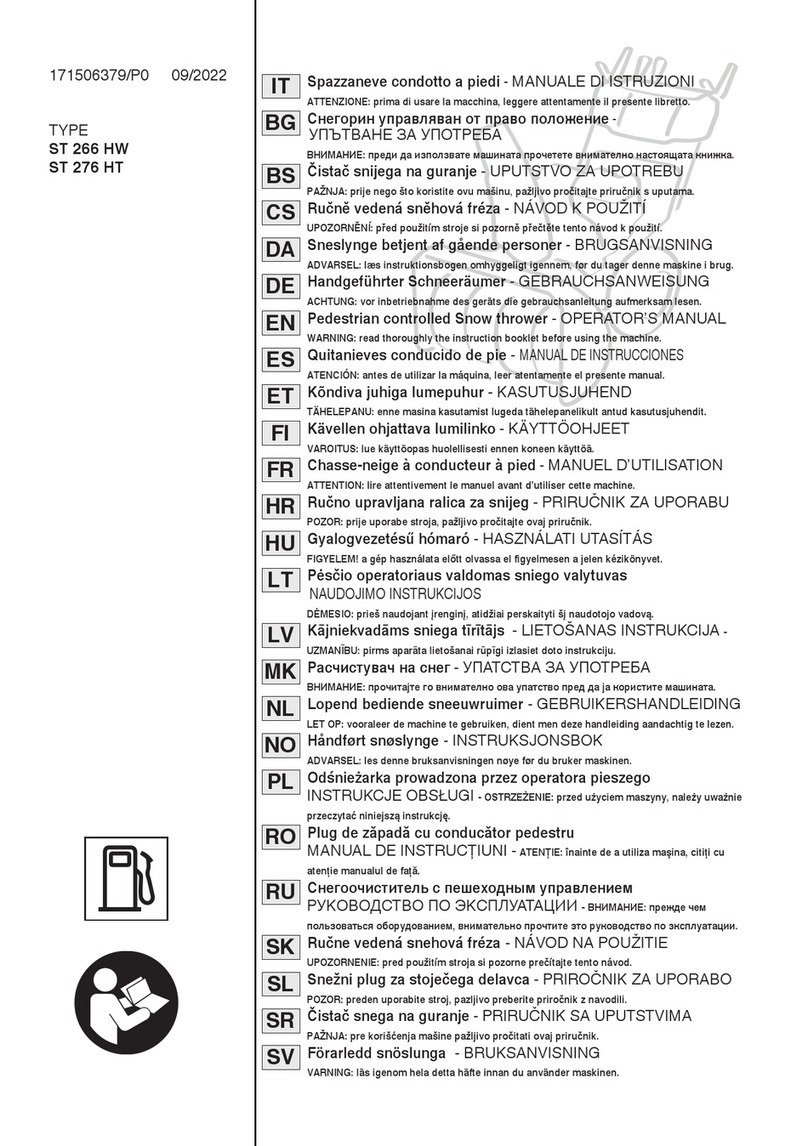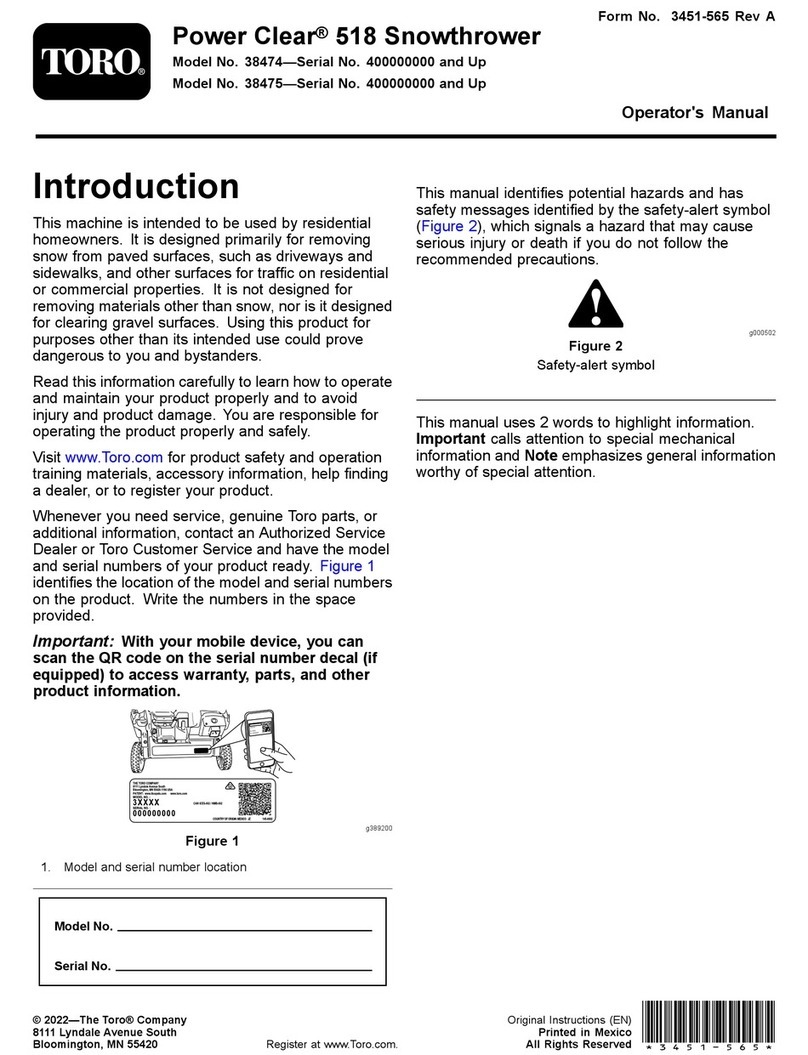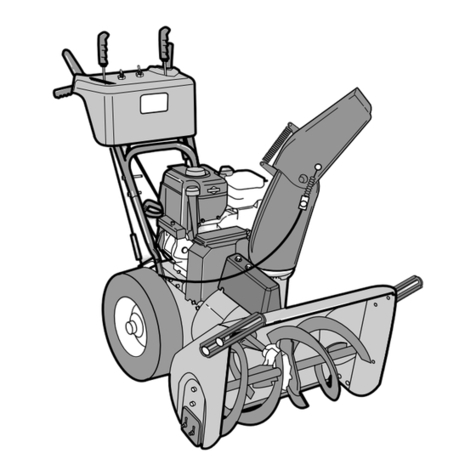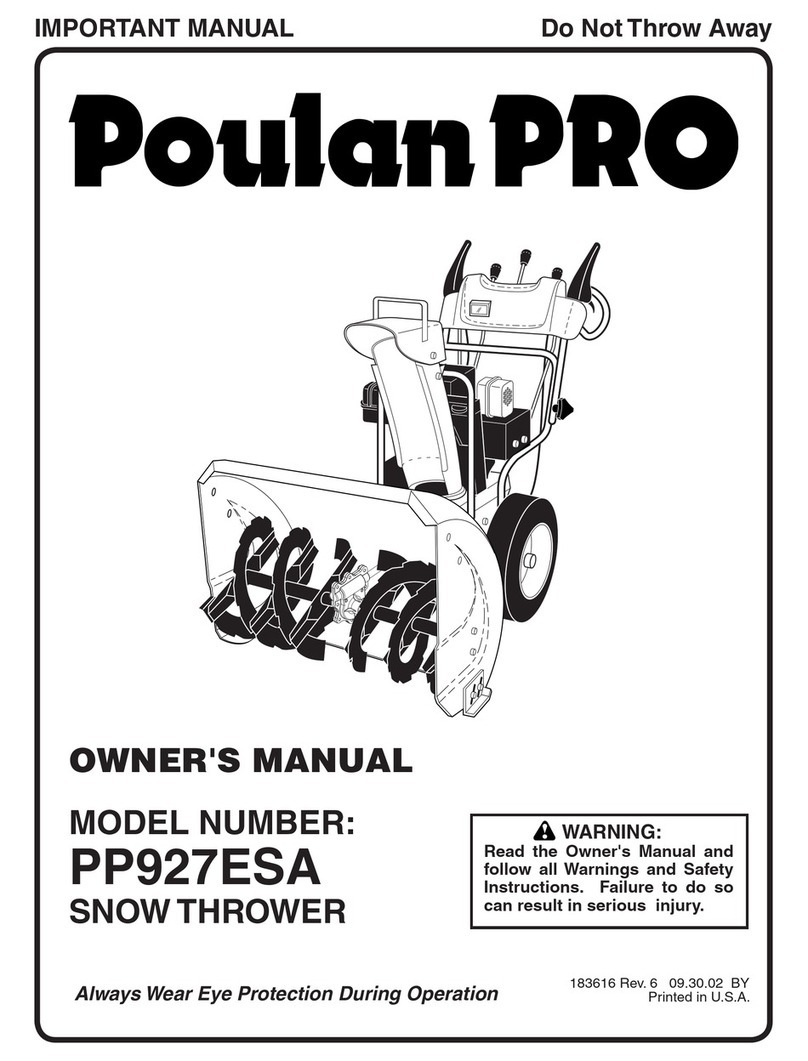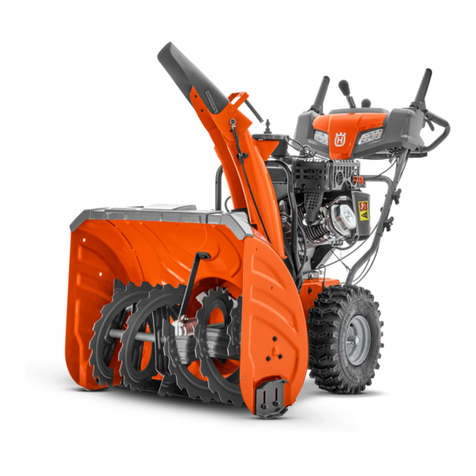Woods SB84.40 User manual

OPERATOR'S MANUALOPERATOR'S MANUAL
(Rev 10/31/2023)
MAN1369
SNOW BLOWER
SB84.40
SB94.40
MAN1369_2023-10.indd 1MAN1369_2023-10.indd 1 11/1/23 4:20 PM11/1/23 4:20 PM

2 Introduction MAN1369
(10/31/2023)
TO THE DEALER:
Assembly and proper installation of this product is the responsibility of the Woods®dealer. Read manual instructions
and safety rules. Make sure all items on the Dealer’s Pre-Delivery and Delivery Checklists in the Operator’s Manual are
completed before releasing equipment to the owner.
The dealer must complete the online Product Registration form at the Woods Dealer Website which certies that
all Dealer Checklist items have been completed. Dealers can register all Woods product at dealer.WoodsEquipment.com
under Product Registration.
Failure to register the product does not diminish customer’s warranty rights.
TO THE OWNER:
Read this manual before operating your Woods equipment. The information presented will prepare you to do a better
and safer job. Keep this manual handy for ready reference. Require all operators to read this manual carefully and
become acquainted with all adjustment and operating procedures before attempting to operate. Replacement man-
uals can be obtained from your dealer. To obtain complete warranty details, visit WoodsEquipment.com/warranty.
You may also request a hard copy by calling 1-800-319-6637 or mail your request to: Woods Equipment Company,
Attn: Warranty Dept. 2606 South Illinois Route 2, Oregon, IL 61061. To locate your nearest dealer, check the Dealer
Locator at www.WoodsEquipment.com, or in the United States and Canada call 1-800-319-6637.
The equipment you have purchased has been carefully engineered and manufactured to provide dependable and sat-
isfactory use. Like all mechanical products, it will require cleaning and upkeep. Lubricate the unit as specied. Observe
all safety information in this manual and safety decals on the equipment.
For service, your authorized Woods dealer has trained mechanics, genuine Woods service parts, and the necessary
tools and equipment to handle all your needs.
Use only genuine Woods service parts. Substitute parts will void the warranty and may not meet standards required
for safe and satisfactory operation. Record the model number and serial number of your equipment in the spaces
provided:
Model: Date of Purchase:
Serial Number: (see Safety Decal section for location)
Provide this information to your dealer to obtain correct repair parts.
Throughout this manual, the term NOTICE is used to indicate that failure to observe can cause damage to equipment.
The terms CAUTION, WARNING, and DANGER are used in conjunction with the Safety-Alert Symbol (a triangle with
an exclamation mark) to indicate the degree of hazard for items of personal safety.
This is the safety alert symbol. It is used to alert you to potential physical
injury hazards. Obey all safety messages that follow this symbol to avoid
possible injury or death.
Indicates a hazardous situation that, if not avoided, will result in death or
serious injury.
Indicates a hazardous situation that, if not avoided, could result in death
or serious injury.
Indicates a hazardous situation that, if not avoided, could result in minor
or moderate injury.
Is used to address practices not related to physical injury.
Indicates helpful information.
DANGER
WARNING
CAUTION
or NOTICE
IMPORTANT
NOTE
MAN1369_2023-10.indd 2MAN1369_2023-10.indd 2 11/1/23 4:20 PM11/1/23 4:20 PM

Introduction 3
MAN1369
(10/31/2023)
This Operator’s Manual should be regarded as part of the machine.
Suppliers of both new and second-hand machines must make sure
that this manual is provided with the machine.
¡LEA EL INSTRUCTIVO!
Si no lee Ingles, pida ayuda a
alguien que si lo lee para que le
traduzca las medidas de seguridad.
TABLE OF CONTENTS
INTRODUCTION. . . . . . . . . . . . . . . . . . . . . . . . . . . . . . . . . . . . . . . . . . . . . . .2
SPECIFICATIONS . . . . . . . . . . . . . . . . . . . . . . . . . . . . . . . . . . . . . . . . 4
GENERAL INFORMATION . . . . . . . . . . . . . . . . . . . . . . . . . . . . . . . . . . . . 4
SAFETY . . . . . . . . . . . . . . . . . . . . . . . . . . . . . . . . . . . . . . . . . . . . . . . . . . . 5
SAFETY RULES . . . . . . . . . . . . . . . . . . . . . . . . . . . . . . . . . . . . . . . . . 5
TRAINING . . . . . . . . . . . . . . . . . . . . . . . . . . . . . . . . . . . . 5
PREPARATION . . . . . . . . . . . . . . . . . . . . . . . . . . . . . . . . . . 5
TRANSPORTATION . . . . . . . . . . . . . . . . . . . . . . . . . . . . . . . 6
OPERATION . . . . . . . . . . . . . . . . . . . . . . . . . . . . . . . . . . . 6
MAINTENANCE . . . . . . . . . . . . . . . . . . . . . . . . . . . . . . . . . 7
STORAGE . . . . . . . . . . . . . . . . . . . . . . . . . . . . . . . . . . . . 7
SAFETY & INSTRUCTIONAL DECALS . . . . . . . . . . . . . . . . . . . . . . . . . . . . . 8
OPERATION . . . . . . . . . . . . . . . . . . . . . . . . . . . . . . . . . . . . . . . . . . . . . . . . 10
OPERATION . . . . . . . . . . . . . . . . . . . . . . . . . . . . . . . . . . . . . . . . . . 12
PRINCIPAL COMPONENTS . . . . . . . . . . . . . . . . . . . . . . . . . . .11
TRACTOR REQUIREMENTS . . . . . . . . . . . . . . . . . . . . . . . . . .11
ATTACHING SNOW BLOWER TO TRACTOR WITH A 3-POINT HITCH . . . .11
ATTACHING SNOW BLOWER TO TRACTOR WITH A QUICK HITCH . . . . .12
DRIVELINE ATTACHMENT. . . . . . . . . . . . . . . . . . . . . . . . . . . .13
MACHINE BREAK-IN . . . . . . . . . . . . . . . . . . . . . . . . . . . . . . .15
OPERATING TECHNIQUE . . . . . . . . . . . . . . . . . . . . . . . . . . . .15
TRANSPORTING . . . . . . . . . . . . . . . . . . . . . . . . . . . . . . . . .17
SNOW REMOVAL METHODS . . . . . . . . . . . . . . . . . . . . . . . . . .17
STORAGE . . . . . . . . . . . . . . . . . . . . . . . . . . . . . . . . . . . .18
CLEANING . . . . . . . . . . . . . . . . . . . . . . . . . . . . . . . . . . . .19
PRE-OPERATION CHECKLIST . . . . . . . . . . . . . . . . . . . . . . . . .19
OWNER SERVICE. . . . . . . . . . . . . . . . . . . . . . . . . . . . . . . . . . . . . . . . . . . . . 20
OWNER SERVICE . . . . . . . . . . . . . . . . . . . . . . . . . . . . . . . . . . . . . . . 20
SERVICE AND MAINTENANCE INTERVALS . . . . . . . . . . . . . . . . . .20
TROUBLESHOOTING. . . . . . . . . . . . . . . . . . . . . . . . . . . . . . . . . . . . . . . . . . . 24
ASSEMBLY . . . . . . . . . . . . . . . . . . . . . . . . . . . . . . . . . . . . . . . . . . . . . . . . 25
ASSEMBLY . . . . . . . . . . . . . . . . . . . . . . . . . . . . . . . . . . . . . . . . . . . 25
DEALER SET-UP INSTRUCTIONS . . . . . . . . . . . . . . . . . . . . . . .25
DEALER CHECKLISTS . . . . . . . . . . . . . . . . . . . . . . . . . . . . . . . . . . . . . . . . . . 31
PARTS INDEX . . . . . . . . . . . . . . . . . . . . . . . . . . . . . . . . . . . . . . . . . . . . . . . 33
APPENDIX. . . . . . . . . . . . . . . . . . . . . . . . . . . . . . . . . . . . . . . . . . . . . . . . . 42
BOLT TORQUE CHART . . . . . . . . . . . . . . . . . . . . . . . . . . . . . . . . . . . . 42
BOLT SIZE CHART & ABBREVIATIONS . . . . . . . . . . . . . . . . . . . . . . . . . . . . 43
FITTING TORQUE CHART . . . . . . . . . . . . . . . . . . . . . . . . . . . . . . . . . . . 44
MAN1369_2023-10.indd 3MAN1369_2023-10.indd 3 11/1/23 4:20 PM11/1/23 4:20 PM

4 Introduction MAN1369
(10/31/2023)
SPECIFICATIONS
GENERAL INFORMATION
■Some illustrations in this manual show the snow
blower with safety shields removed to provide a
better view. The snow blower should never be
operated with any safety shielding removed.
The purpose of this manual is to assist you in operating
and maintaining your snow blower. Read it carefully.
It furnishes information and instructions that will help
you achieve years of dependable performance. These
instructions have been compiled from extensive eld
experience and engineering data. Some information
may be general in nature due to unknown and varying
operating conditions. However, through experience
and these instructions, you should be able to develop
procedures suitable to your particular situation.
The illustrations and data used in this manual were cur-
rent at the time of printing, but due to possible inline
production changes, your machine may vary slightly in
detail. We reserve the right to redesign and change the
machines as may be necessary without notication.
Throughout this manual, references are made to right,
left, forward and rearward directions. These are deter-
mined by sitting in the tractor operator’s seat facing the
direction of forward travel.
WARNING
Model Number SB84.40 SB94.40
Type 2 Stage 2 Stage
Working Width 84" 94"
Working Height 34" 34"
Maximum Operating Weight 1130 Lbs 1180 Lbs
Input Driveline Spec Series 50 Series 60
Driveline Torque Protection Shear Bolt Shear Bolt
Fan Diameter 27-1/2" 27-1/2"
Fan Depth 10-1/2" 10-1/2"
Number of Fan Blades 4 4
Fan Shaft Diameter 40 mm (1.57") 40 mm (1.57")
Fan Speed 540 RPM 540 RPM
Gearbox Ratio 1 : 1 1 : 1
Side Drive Shaft 32mm (1.26") 32mm (1.26")
Side Drive Sprocket 10 10
Number of Augers 1 1
Auger Diameter 20" 20"
Auger Speed 170 RPM 170 RPM
Auger Flighting Size 3/8" x 3" 3/8" x 3"
Auger Tube 3-1/2" 3-1/2"
Auger Drive Chain Size #60H #60H
Auger Torque Protection Shear Bolt Shear Bolt
Auger Sprocket 32 32
Bearing Type 4-Bolt Flange 4-Bolt Flange
Bearing Diameter 1-1/4" 1-1/4"
Chute Shape Octagonal Octagonal
Chute Diameter 11" 11"
Chute Rotation Angle 210° 210°
Standard Chute Rotation Manual Manual
Optional Chute Rotation Hydraulic Cylinder Hydraulic Cylinder
Standard Chute Deector Manual Manual
Optional Chute Deectors Hydraulic, or Electric Hydraulic, or Electric
Cutting Edge Type Welded Welded
Cutting Edge Size 1/2" x 3" 1/2" x 3"
Skid Shoe Type Adjustable Adjustable
Shipping Weight - Crated 970 Lbs 1020 Lbs
Overall Width 84" 94"
Overall Height 74" 74"
Overall Length 55-3/8" 55-3/8"
Tractor PTO Speed 540 RPM 540 RPM
Tractor PTO Horsepower 35 - 90 35 - 90
Tractor 3-Point Hitch Category 1 or 2 Category 2
Quick Hitch Compatible Standard Standard
MAN1369_2023-10.indd 4MAN1369_2023-10.indd 4 11/1/23 4:20 PM11/1/23 4:20 PM

Safety 5
MAN1369
(10/31/2023)
TRAINING
■This machine is capable of amputating hands
and feet and throwing objects. Failure to ob-
serve the following safety instructions could
result in serious injury or death.
■Safety instructions are important! Read all
attachment and power unit manuals; follow
all safety rules and safety decal information.
(Replacement manuals and safety decals are
available from your dealer. To locate your
nearest dealer, check the Dealer Locator at
www.WoodsEquipment.com, or in the United
States and Canada call 1-800-319-6637.) Failure
to follow instructions or safety rules can result
in serious injury or death.
■If you do not understand any part of this manual
and need assistance, see your dealer.
■Know your controls and how to stop engine and
attachment quickly in an emergency.
■Operators must be responsible, trained, familiar
with the instructions and be physically capa-
ble of the safe operation of the equipment, its
attachments, and all controls. Do not allow any-
one to operate this equipment without proper
instructions.
■Keep hands and body away from pressurized
lines. Use paper or cardboard, not hands or
other body parts to check for leaks. Wear safe-
ty goggles. Hydraulic uid under pressure can
easily penetrate skin and will cause serious in-
jury or death.
■Make sure that all operating and service person-
nel know that if hydraulic uid penetrates skin,
it must be surgically removed as soon as possi-
ble by a doctor familiar with this form of injury
or gangrene, serious injury, or death will result.
CONTACT A PHYSICIAN IMMEDIATELY IF FLUID
ENTERS SKIN OR EYES. DO NOT DELAY.
■Never allow children or untrained persons to op-
erate equipment.
PREPARATION
■Check that all hardware is properly installed.
Always tighten to Bolt Torque Chart specica-
tions unless instructed otherwise in this manual.
■Air in hydraulic systems can cause erratic opera-
tion and allows loads or equipment components
to drop unexpectedly. When connecting equip-
ment or hoses or performing any hydraulic
maintenance, purge any air in hydraulic sys-
tem by operating all hydraulic functions several
times. Do this before putting into service or al-
lowing anyone to approach the equipment.
■Route hydraulic hoses carefully to prevent dam-
age. Hoses must not be twisted, bent sharply,
kinked, frayed, pinched, or come into contact
with any moving parts. Operate moveable com-
ponents through full operational range to
check clearances. Replace any damaged hose
immediately.
■ Make sure all hydraulic hoses, ttings, and
valves are in good condition and not leaking
before starting power unit or using equipment.
Check and route hoses carefully to prevent
damage. Hoses must not be twisted, bent sharp-
ly, kinked, frayed, pinched, or come into contact
with any moving parts. Operate moveable com-
ponents through full operational range to
check clearances. Replace any damaged hoses
immediately.
■Always wear relatively tight and belted clothing
to avoid getting caught in moving parts. Wear
sturdy, rough-soled work shoes and protec-
tive equipment for eyes, hair, hands, hearing,
and head; and respirator or lter mask where
appropriate.
■Power unit must be equipped with Roll Over
Protection System (ROPS) or ROPS cab and
seat belt. Keep seat belt securely fastened.
Falling off power unit can result in death from
being run over or crushed. Keep foldable ROPS
system in “locked up” position at all times.
■Make sure attachment is properly secured, ad-
justed, and in good operating condition.
■Make sure all safety decals are installed.
Replace if damaged. (See Safety Decals section
for location.)
■Make sure shields and guards are proper-
ly installed and in good condition. Replace if
damaged.
Safety is a primary concern in the design and man-
ufacture of our products. Unfortunately, our efforts
to provide safe equipment can be wiped out by an
operator’s single careless act.
In addition to the design and conguration of
equipment, hazard control and accident preven-
tion are dependent upon the awareness, concern,
judgement, and proper training of personnel in-
volved in the operation, transport, maintenance,
and storage of equipment.
It has been said, “The best safety device is an in-
formed, careful operator.” We ask you to be that
kind of operator.
SAFETY RULES
ATTENTION! BECOME ALERT! YOUR SAFETY IS INVOLVED!
MAN1369_2023-10.indd 5MAN1369_2023-10.indd 5 11/1/23 4:20 PM11/1/23 4:20 PM

6 Safety MAN1369
(10/31/2023)
■Do not leave a running machine unattended.
Always park on level ground, disengage tractor
PTO, set parking brake, and stop engine.
■Make sure spring-activated locking pin or collar
slides freely and is seated rmly in tractor PTO
spline groove.
■A minimum 20% of tractor and equipment
weight must be on the tractor front wheels when
attachments are in transport position. Without
this weight, front tractor wheels could raise up
resulting in loss of steering. The weight may
be attained with front wheel weights, ballast in
tires, front tractor weights or front loader. Weigh
the tractor and equipment. Do not estimate.
■Inspect and clear area of stones, branches, or
other hard objects that might be thrown, caus-
ing injury or damage.
TRANSPORTATION
■Always comply with all state and local lighting
and marking requirements.
■Do not operate PTO during transport.
■Do not operate or transport on steep slopes.
■Before dismounting power unit or perform-
ing any service or maintenance, follow these
steps: disengage power to equipment, lower
the 3-point hitch and all raised components to
the ground, operate valve levers to release any
hydraulic pressure, set parking brake, stop en-
gine, remove key, and unfasten seat belt.
OPERATION
■Never place hands or body into discharge chute
or auger to unclog. Stored energy can cause
auger to quickly rotate when unclogging occurs
and cause severe injury or amputation. Stop
engine, remove key, disconnect driveline, and
carefully unclog, using a sturdy piece of wood.
■Keep the area of operation clear of all bystand-
ers, particularly small children [within 300 ft (92
m)]. Stop the machine and attachments(s) if
anyone enters the area.
■Be alert and turn the machine off if children
enter the work area.
■Before and when backing, look behind for small
children.
■Never carry children while operating the ma-
chine. They may fall off and be seriously injured
or interfere with the safe operation of the
machine.
■Use extra care when approaching blind corners,
shrubs, trees, or other obstructions that might
hide children from sight.
■Never direct discharge toward people, animals,
or property. Rocks, snow, ice and other materials
can be thrown up to 300 feet during operation.
■Do not operate or transport equipment while
under the inuence of alcohol or drugs.
■ Operate only in daylight or good articial light.
■Keep hands, feet, hair, and clothing away from
equipment while engine is running. Stay clear of
all moving parts.
■Never allow riders on power unit or attachment.
■Power unit must be equipped with Roll Over
Protection System (ROPS) or ROPS cab and
seat belt. Keep seat belt securely fastened.
Falling off power unit can result in death from
being run over or crushed. Keep foldable ROPS
system in “locked up” position at all times.
■Always sit in power unit seat when operating
controls or starting engine. Securely fasten
seat belt, place transmission in neutral, engage
brake, and ensure all other controls are disen-
gaged before starting power unit engine.
■Operate tractor PTO at 540 RPM. Do not exceed.
■Connect PTO driveline directly to power unit
PTO shaft. Never use adapter sleeves or adapt-
er shafts. Adapters can cause driveline failures
due to incorrect spline or incorrect operating
length and can result in personal injury or death.
■Only engage power when equipment is at ground
operating level. Always disengage power when
equipment is raised off the ground.
■Look down and to the rear and make sure area is
clear before operating in reverse.
■Do not stop, start, or change directions sudden-
ly on slopes.
■Use extreme care and reduce ground speed on
slopes and rough terrain.
SAFETY RULES
ATTENTION! BECOME ALERT! YOUR SAFETY IS INVOLVED!
MAN1369_2023-10.indd 6MAN1369_2023-10.indd 6 11/1/23 4:20 PM11/1/23 4:20 PM

Safety 7
MAN1369
(10/31/2023)
■Use extreme care when working close to fences,
ditches, other obstructions, or on hillsides.
■Watch for hidden hazards on the terrain during
operation.
■ Watch for trafc when operating near or cross-
ing roadways.
■Use extreme caution when operating on, or
crossing a gravel driveway and direct discharge
in a safe direction.
■Stop power unit and equipment immediately
upon striking an obstruction. Turn off engine,
remove key, inspect, and repair any damage be-
fore resuming operation.
■If the implement starts to vibrate abnormally,
disengage the PTO, stop the engine immediate-
ly and check for cause.
■Before performing any service or maintenance,
disconnect driveline from tractor PTO.
MAINTENANCE
■Before dismounting power unit or perform-
ing any service or maintenance, follow these
steps: disengage power to equipment, lower
the 3-point hitch and all raised components to
the ground, operate valve levers to release any
hydraulic pressure, set parking brake, stop en-
gine, remove key, and unfasten seat belt.
■Before performing any service or maintenance,
disconnect driveline from tractor PTO.
■NEVER GO UNDERNEATH EQUIPMENT. Never
place any part of the body underneath equip-
ment or between moveable parts even when the
engine has been turned off. Hydraulic system
leak-down, hydraulic system failures, mechan-
ical failures, or movement of control levers can
cause equipment to drop or rotate unexpectedly
and cause severe injury or death.
• Service work does not require going under-
neath implement.
• Read Operator’s Manual for service in-
structions or have service performed by a
qualied dealer.
■Service and maintenance work not covered in
OWNER SERVICE must be done by a qualied
dealership. Special skills, tools, and safety pro-
cedures may be required. Failure to follow these
instructions can result in serious injury or death.
■Do not modify or alter or permit anyone else to
modify or alter the equipment or any of its com-
ponents in any way.
■Your dealer can supply original equipment hy-
draulic accessories and repair parts. Substitute
parts may not meet original equipment speci-
cations and may be dangerous.
■Always wear relatively tight and belted clothing
to avoid getting caught in moving parts. Wear
sturdy, rough-soled work shoes and protec-
tive equipment for eyes, hair, hands, hearing,
and head; and respirator or lter mask where
appropriate.
■Make sure attachment is properly secured, ad-
justed, and in good operating condition.
■Always make sure any material and waste prod-
ucts from the repair and maintenance of the
implement are properly collected and disposed.
■Keep all persons away from operator control
area while performing adjustments, service, or
maintenance.
■Tighten all bolts, nuts, and screws to Bolt Torque
Chart specications. Check that all cotter pins
are installed securely to ensure equipment is in
a safe condition before putting unit into service.
■Make sure all safety decals are installed.
Replace if damaged. (See Safety Decals section
for location.)
■Make sure shields and guards are proper-
ly installed and in good condition. Replace if
damaged.
■Do not disconnect hydraulic lines until engine
is stopped, power unit is properly secured,
equipment and all components are lowered to
the ground, and system pressure is released by
operating all valve control levers.
■ Use a suitable lifting device of sufcient capac-
ity. Use adequate personnel to handle heavy
components.
■ For continued protection against risk of re,
replace ONLY with a fuse of the same type and
having the same electrical rating.
STORAGE
■Block equipment securely for storage.
■Keep children, bystanders and animals away
from the equipment and the storage area.
MAN1369_2023-10.indd 7MAN1369_2023-10.indd 7 11/1/23 4:20 PM11/1/23 4:20 PM

8 Safety MAN1369
(10/31/2023)
1015373
W2500833
W2500784
W2500783
642629
W2500783
W2500791
W2500785
CD9360 AA
W2500786
W2500795
W2500794
1033600
1021069
W2500792
18869
15502
W2500833
W2500783
W2500783
18869
W2500782
W664383 57123
57123
1033600
W2500782
W656808
W664383
SAFETY & INSTRUCTIONAL DECALS
ATTENTION! BECOME ALERT! YOUR SAFETY IS INVOLVED!
Replace Immediately If Damaged!
DANGER
ROTATING DRIVELINE
CONTACT CAN CAUSE DEATH
KEEP AWAY!
DO NOT OPERATE WITHOUT -
All driveline guards, tractor and equipment
shields in place.
Drivelines securely attached at both ends.
Driveline guards that turn freely on driveline.
1033600
ARBRE DE TRANSMISSION EN ROTATION
LE CONTACT PEUT CAUSER LA MORT
NE PAS S'APPROCHER !
NE PAS UTILISER SANS -
tous les carters d'arbre de transmission ainsi
que toutes les protections du tracteur et de
l'équipement en place.
les arbres de transmission fermement fixés
aux deux extrémités.
des carters tournant librement sur l'arbre
de transmission.
4.13”W X 5.50”H including .12” White Border (4 sides)
Decal 1033600
Ctgy 3006
DCL, DNGR, ROTATING DRIVELINE
W2500606
W656808
BE CAREFUL!
Keep safety decals clean and visible.
Use a clean, damp cloth to clean safety decals.
Avoid spraying too close to decals when using a pressure washer;
high-pressure water can enter through very small scratches or
under edges of decals causing them to peel or come off.
Replace safety decals if they are missing or illegible.
Replacement safety decals can be ordered free from your Woods
dealer, or in the United States and Canada call 1-800-319-6637.
SERIAL NUMBER PLATE
MAN1369_2023-10.indd 8MAN1369_2023-10.indd 8 11/1/23 4:20 PM11/1/23 4:20 PM

Safety 9
MAN1369
(10/31/2023)
W2500783
15502 18869 642629 1015373 1021069
W2500794 W2500795 W2500833 W2500785
W2500784 W2500786 W2500791 W2500792
SAFETY & INSTRUCTIONAL DECALS
ATTENTION! BECOME ALERT! YOUR SAFETY IS INVOLVED!
Replace Immediately If Damaged!
W2500784
W2500786
W2500791
W2500792
W2500794
W2500795
W2500833
WARNING
ROTATING COMPONENTS
CONTACT WITH ROTATING PARTS
CAN CAUSE SERIOUS INJURY. 15502
Do not operate without cover in place.
Look and listen for rotation. Do not
open cover until all components have
stopped.
SHIELD MISSING
DO NOT OPERATE - PUT SHIELD ON
18869
DANGER
1044569
2.50"W x 2.25"H
incl .125 Orange
Border 4 Sides &
.125 Radius Cut Corners
DECAL PART #: 1015373
DECAL DESCRIPTION: DECAL, WARNING PINCH POINT HZD
REV AC 6/1219 TKH
WARNING
1015373
PINCH POINT
HAZARD
Keep clear.
13.0 H x 2.6875" W
DECAL 1021069 (Ref 1004622)
CTGY 3004
DCL, WRNG, PINCH/DROP/CRUSH
4/5/06 CAW
REV AB - KRD 9/18/23
WARNING
DANGER
RAISED IMPLEMENT
CAN DROP AND CRUSH
n Never go underneath
raised implement which
can drop from equipment
or tractor 3-point hitch
hydraulic leak down,
hydraulic system
failures, movement of
control levers, or
mechanical linkage
failures.
n Service work does not
require going underneath
implement. Read manual
instructions.
GOING UNDERNEATH
IMPLEMENT WILL
RESULT IN SERIOUS
INJURY OR DEATH.
CRUSHING AND
PINCHING HAZARD
nHandle machine parts
carefully. Body parts
could be crushed or
pinched between tractor
and implement.
n Operate tractor controls
from tractor seat only.
n Do not stand between
tractor and implement
when tractor is in gear.
nMake sure parking brake
is engaged before going
between tractor and
implement.
nStand clear of machine
while in operation or
when it is being raised
or lowered.
FAILURE TO FOLLOW
THESE INSTRUCTIONS
CAN RESULT IN
INJURY OR DEATH.
1021069 AB
MAN1369_2023-10.indd 9MAN1369_2023-10.indd 9 11/1/23 4:20 PM11/1/23 4:20 PM

10 Operation MAN1369
(10/31/2023)
OPERATION
The operator is responsible for the safe operation of
the snow blower. The operator must be properly
trained. Operators should be familiar with the tractor,
snow blower, and all safety practices before starting
operation. Read through safety rules and decals on
page 5 through page 9.
■Safety instructions are important! Read all
attachment and power unit manuals; follow
all safety rules and safety decal information.
(Replacement manuals and safety decals are
available from your dealer. To locate your near-
est dealer, check the Dealer Locator at www.
WoodsEquipment.com, or in the United States
and Canada call 1-800-319-6637.) Failure to fol-
low instructions or safety rules can result in
serious injury or death.
■Operators must be responsible, trained, familiar
with the instructions and be physically capa-
ble of the safe operation of the equipment, its
attachments, and all controls. Do not allow any-
one to operate this equipment without proper
instructions.
■Power unit must be equipped with ROPS or
ROPS cab and seat belt. Keep seat belt secure-
ly fastened. Falling off power unit can result in
death from being run over or crushed. Keep
foldable ROPS system in “locked up” position
at all times.
■Do not allow bystanders in the area when op-
erating, attaching, removing, assembling, or
servicing equipment.
■Never allow children or untrained persons to op-
erate equipment.
■Never go underneath equipment (lowered to the
ground or raised) unless it is properly blocked
and secured. Never place any part of the body
underneath equipment or between moveable
parts even when the engine has been turned off.
Hydraulic system leak down, hydraulic system
failures, mechanical failures, or movement of
control levers can cause equipment to drop or
rotate unexpectedly and cause severe injury or
death. Follow Operator’s Manual instructions
for working underneath and blocking require-
ments or have work done by a qualied dealer.
■Keep bystanders away from equipment.
■Keep hands, feet, hair, and clothing away from
equipment while engine is running. Stay clear of
all moving parts.
■Never place hands or body into discharge chute
or auger to unclog. Stored energy can cause
auger to quickly rotate when unclogging occurs
and cause severe injury or amputation. Stop
engine, remove key, disconnect driveline, and
carefully unclog, using a sturdy piece of wood.
■Keep hands and body away from pressurized
lines. Use paper or cardboard, not hands or
other body parts to check for leaks. Wear safe-
ty goggles. Hydraulic uid under pressure can
easily penetrate skin and will cause serious in-
jury or death.
■Make sure that all operating and service person-
nel know that if hydraulic uid penetrates skin,
it must be surgically removed as soon as possi-
ble by a doctor familiar with this form of injury
or gangrene, serious injury, or death will result.
CONTACT A PHYSICIAN IMMEDIATELY IF FLUID
ENTERS SKIN OR EYES. DO NOT DELAY.
■Before dismounting power unit or perform-
ing any service or maintenance, follow these
steps: disengage power to equipment, lower
the 3-point hitch and all raised components to
the ground, operate valve levers to release any
hydraulic pressure, set parking brake, stop en-
gine, remove key, and unfasten seat belt.
■Make sure spring-activated locking pin or collar
slides freely and is seated rmly in tractor PTO
spline groove.
■Operate tractor PTO at 540 RPM. Do not exceed.
■Make sure attachment is properly secured, ad-
justed, and in good operating condition.
■If you do not understand any part of this manual
and need assistance, see your dealer.
■Always wear relatively tight and belted clothing
to avoid getting caught in moving parts. Wear
sturdy, rough-soled work shoes and protective
equipment for eyes, hair, hands, hearing, and
head; and respirator or lter mask where
appropriate.
■Be sure to complete the Pre-Operation Check
List on page 19 prior to operating this Snow
Blower.
WARNING
CAUTION
NOTICE
MAN1369_2023-10.indd 10MAN1369_2023-10.indd 10 11/1/23 4:20 PM11/1/23 4:20 PM

Operation 11
MAN1369
(10/31/2023)
PRINCIPAL COMPONENTS
The snow blower has three main operating compo-
nents. An auger dislodges the snow and carries it to a
central fan. The snow is then discharged by the fan and
directed away from the blower through a controllable
chute.
The snow blower is mounted on a tractor 3-point hitch
and driven by the tractor PTO. A centrally located gear-
box directs power to the fan and auger.
TRACTOR REQUIREMENTS
3-Point Hitch
The SB84.40 snow blowers require the tractor to be
equipped with a Category 1 or Category 2 three-point
hitch. The SB94.40 snow blowers require the tractor to
be equipped with a Category 2 three-point hitch.
Hydraulic Circuit
Either closed-center or open-center systems can be
used for the optional hydraulic spout control.
Tire Conguration
For best results, the tractor wheels should be set nar-
rower than the cutting width of the snow blower. Wider
wheel settings will cause snow to be pulled under the
tractor and may require additional passes.
PTO Shaft
The tractor must be congured to accept a 1-3/8" 6-
spline 540 RPM system and must meet horsepower
specications. See specications, page 4.
Tractor Stability
■A minimum 20% of tractor and equipment weight
must be on the tractor front wheels when attach-
ments are in transport position. Without this
weight, front tractor wheels could raise up re-
sulting in loss of steering. The weight may be
attained with front wheel weights, ballast in
tires, front tractor weights or front loader. Weigh
the tractor and equipment. Do not estimate.
Figure 1. Tractor Stability (Typical)
ATTACHING SNOW BLOWER TO
TRACTOR WITH A 3-POINT HITCH
Figure 2
1. Make sure the parking stand is lowered. To do this,
remove the round wire lock pin (item 9) from the
parking stand (item 8), lower the parking stand and
insert the round wire lock pin (item 9) under the
snow blower attachment tube.
2. Move the tractor into position in front of the snow
blower. Move back slowly and carefully, not allowing
anyone to be between the tractor and the snow blower.
3. Turn off the tractor engine.
4. Attach the tractor lower arms with the two pins (item
1 for Cat 2 hitch, or item 2 for Cat 1 hitch) and se-
cure in place with the 7/16" ring pins (item 4) in the
upper holes for small tractors and in the lower holes
for larger tractors.
5. Attach the tractor top link between the upper attach-
ment plates of the snow blower with the pin and the
ring pin (items 3 & 4) provided with the tractor.
6. Adjust the snow blower using the tractor top link so
that the back of the snow blower housing is perpen-
dicular to the ground.
7. Adjust the anti-sway devices of the tractor to pre-
vent lateral swinging of the snow blower. Make sure
there is no contact with the tires.
8. Raise the parking stand. To do this, remove the
round wire lock pin (item 9) from the parking stand
(item 8), raise the parking stand and insert the
round wire lock pin (item 9) over the snow blower
attachment tube.
9. Go to Driveline Attachment section for further
instructions.
■Before connecting the snow blower driveline to
tractor drive shaft, make sure driveline is not
too long in raised, lowered and middle position.
If the driveline is too long it must be shortened,
to avoid damaged to tractor. See pages 13 to 15
for instructions.
Figure 2. Attaching with a 3-Point Hitch
CD1564
CAUTION
1
2
3
4
4
4
9
8
CD9362 AA
MAN1369_2023-10.indd 11MAN1369_2023-10.indd 11 11/1/23 4:20 PM11/1/23 4:20 PM

12 Operation MAN1369
(10/31/2023)
ATTACHING SNOW BLOWER TO
TRACTOR WITH A QUICK HITCH
Figure 3
1. Make sure the parking stand is lowered. To do this,
remove the round wire lock pin (item 9) from the
parking stand (item 8), lower the parking stand and
insert the round wire lock pin (item 9) under the
snow blower attachment tube.
2. Move the tractor into position in front of the snow
blower. Move back slowly and carefully, not allow-
ing anyone to be between the tractor and the snow
blower.
3. Turn off the tractor engine.
4. Install lower hitch pins and bushings:
• For Cat 1, insert a 1-7/16" OD x 2-1/8" long
bushing (item 6) between the inner hitch plates
and secure with the pin and ring pin (items 2
& 4).
• For Cat 2, insert a 1-7/16" OD x 3-3/8" long
bushing (item 5) between the outer hitch plates
and secure in the upper holes with the pin and
ring pin (items 1 & 4).
• Repeat for the opposite side.
5. Insert a Insert a 1-1/4" OD x 1-7/8" long long bush-
ing (item 7) between the plates of the snow blower
upper hitch and secure with the pin and the linchpin
(items 3 & 4) provided with the tractor.
6. Make sure that the quick release latches are se-
curely closed. Lower the 3-Point so that the hooks
on the quick hitch are lower than the snow blower
pins and bushings. Reverse the tractor slowly until
the hooks are under snow blower pins and bush-
ings. Then, raise the 3-Point until the quick-release
latches snap on the pins with the snow blower bush-
ings to lock the system.
7. Adjust the snow blower using the tractor top link so
that the back of the snow blower housing is perpen-
dicular to the ground.
8. Raise the parking stand. To do this, remove the
round wire lock pin (item 9) from the parking stand
(item 8), raise the parking stand and insert the
round wire lock pin (item 9) over the snow blower
attachment tube.
9. Go to Driveline Attachment section for further
instructions.
■Before connecting the snow blower driveline to
tractor drive shaft, make sure driveline is not
too long in raised, lowered and middle position.
If the driveline is too long it must be shortened,
to avoid damaged to tractor. See pages 13 to 15
for instructions.
Figure 3. Attaching with a Quick Hitch
■If the PTO driveline is too long, severe driveline
and gearbox damage is possible when hooking
up the PTO driveline from the rotary snow blow-
er to the tractor. The front PTO driveline is long
enough to t a variety of tractors. It is possible
that the front PTO driveline will need to be cut.
There will be NO benet by cutting only one tele-
scoping section. Both sections of the driveline
must be cut. DO NOT FORCE THE PTO TO FIT.
■If attaching with quick hitch, the distance be-
tween the tractor PTO and gearbox input
shaft will increase. Please follow the steps as
you would for a 3-point hitch to insure proper
engagement.
■When attaching snow blower to multiple trac-
tors consider the drive length needed for each
tractor and whether the drive line will work in all
combinations.
■WARRANTY IS VOID IF THE PTO DRIVELINE IS
TOO LONG, resulting in gearbox, PTO, yoke or
cross bearing damage.
NOTICE
CAUTION
1
CD9363 AA
2
3
4
4
4
5
6
7
8
9
MAN1369_2023-10.indd 12MAN1369_2023-10.indd 12 11/1/23 4:20 PM11/1/23 4:20 PM

Operation 13
MAN1369
(10/31/2023)
Figure 4. Driveline Joint Angles
DRIVELINE ATTACHMENT
Preparation of the Driveline
IMPORTANT: To obtain the proper universal joint an-
gles, it is recommended to adjust the 3-Point hitch at
the furthest point from the tractor recommended by the
manufacturer. The universal joint angle is directly re-
lated with the life of driveline. To reduce the angle, it is
necessary to increase the distance between the snow
blower and the tractor.
IMPORTANT: Do not change the snow blower angle on
the tractor hitch to obtain a better scraping effect. Avoid
this practice as it can damage the driveline since the
joint angle at each end is unequal. This results in a fan
speed variation as well as an increased load on drive-
line bearings. It is always recommended to keep tractor
PTO shaft and snow blower input shaft parallel.
Determining Driveline Length
Figures 5 & 6
IMPORTANT: Before using the snow blower, make
sure the driveline is the proper length. There must be
sufcient overlap of the inner and outer drive tubes but
there must not be any interference.
1. To determine the “L” length for your tractor model
rst nd the “X” distance by measuring between the
end of the tractor’s PTO shaft and the end of the
snow blower’s input shaft when the snow blower is
in transport position as shown, when raised to max-
imum height.
L = X - Y
3-Point Hitch Y
Category 1 4-1/2"
Category 2 5-1/2"
Driveline Joint Angles too Large – Avoid
Driveline Joint Angles Unequal – Avoid
Driveline Joint Angles Reduced – Acceptable
Driveline Joint Angles Equal – Recommended
MAN1369_2023-10.indd 13MAN1369_2023-10.indd 13 11/1/23 4:20 PM11/1/23 4:20 PM

14 Operation MAN1369
(10/31/2023)
Figure 5. Find the “X” Distance
2. From the table on the preceding page, use the “Y”
value according to the 3-point hitch category and
subtract that number from the “X” distance mea-
sured previously to determine “L”.
3. Hold the two half-shafts side by side and locate the
“L” length between the two center-to-center half-
shaft universal joints. Mark off the zone to be cut
on both halves opposite each half-shaft guard as
shown in Figure 6.
4. Cut inner and outer plastic guard tubes.
5. Cut the steel tubes to leave the 1-1/4" between the
end of the guard and the end of each tube.
6. File the ends of the tubes to remove burrs and clean
out any chips.
7. Apply grease to the inside of the female tube section.
Driveline Installation
Figure 7
1. Remove the paint from the gearbox shaft (item 1)
and grease if needed. Grease also the sliding sur-
faces and yoke of the driveline.
2. Remove the bolts (item 3) from the yoke and slide
the driveline (item 1) on the gearbox shaft.
3. Secure the driveline by resinstalling the bolts and
nuts (items 3 & 4) in the orientation shown. Tighten
the nuts according to the Bolt Torque Chart speci-
cations at the end of the manual.
4. Raise the snow blower slowly to the maximum
height while ensuring that there is enough room be-
tween the two sections of the driveline. Also make
sure it is long enough when lowered.
■Avoid serious injury or death – This shaft rotates
at high speed (540 RPM). If the quick release
system is not securely locked on the tractor
shaft, (a click must be heard), or if the coupling
to the snow blower is not secured correctly, the
driveline can be released with force which can
cause serious injury or death.
Figure 6. Determining Driveline Length
WARNING
MAN1369_2023-10.indd 14MAN1369_2023-10.indd 14 11/1/23 4:20 PM11/1/23 4:20 PM

Operation 15
MAN1369
(10/31/2023)
Figure 7. Driveline Installation
MACHINE BREAK-IN
Although there are no operational restrictions on the
snow blower when used for the rst time, the following
items are to be checked.
After operating for 1/2 hour:
1. Check all nuts, bolts and other fasteners. Tighten to
the specications shown in the Bolt Torque Chart.
2. Check drive chain tension. Adjust as required.
3. Check that auger, fan and chute are in good
condition.
4. Check oil level in the gearbox. Add as required.
5. Lubricate all grease points.
After operating for 5 to 10 hours:
1. Repeat items 1 through 4 of Section A.
2. Then go to normal Owner Service Section, page 20.
OPERATING TECHNIQUE
Each operator should review this section of the manual
at the start of the season and as often as required to
be familiar with the machine. When using, follow this
procedure:
1. Review and follow the “Pre-Operation Check List,”
page 19.
2. Review “Attaching Snow Blower to Tractor” section,
page 11.
3. Before going to the eld, review “Transporting” sec-
tion, page 17.
4. Position snow blower in a level area and lower into
working position. Make sure the parking stand is in
the raised position and that the snow blower is clear
of snow and other material.
5. Starting Snow Blower:
• Be sure area is clear of all bystanders.
• Run engine at low idle.
• Slowly engage PTO control to start machine.
• Slowly bring engine to rated PTO speed. Never
exceed rated speed
6. Stopping Machine:
• Slowly decrease engine speed to low idle.
• Wait until PTO drive and snow blower have
slowed to low engine idle speed before disen-
gaging PTO drive.
■Before dismounting power unit or perform-
ing any service or maintenance, follow these
steps: disengage power to equipment, lower
the 3-point hitch and all raised components to
the ground, operate valve levers to release any
hydraulic pressure, set parking brake, stop en-
gine, remove key, and unfasten seat belt.
■Before performing any service or maintenance,
disconnect driveline from tractor PTO.
7. Do not operate with bystanders in area. The ma-
chine can pick up stones, sticks, wire and other
debris and throw it out with enough force to cause
severe injury or death to bystanders. Shut down
machine and wait for moving parts to stop before
approaching machine.
8. Ground Speed: Travel speed can vary between
1.5 and 7 mph depending on material and terrain
conditions. It is the responsibility of the operator to
note the condition of the job being done and set the
speed to obtain proper feeding rate and maintain
safe control of machine.
9. The input driveline and side drive shaft are both
protected by shear bolts in case of shock load from
striking an obstruction. To access the shear bolts,
lift the guards, (items 3 and 4). See parts section for
bolt size and grade.
WARNING
3
2
1
CD9364 AA
MAN1369_2023-10.indd 15MAN1369_2023-10.indd 15 11/1/23 4:20 PM11/1/23 4:20 PM

16 Operation MAN1369
(10/31/2023)
■Never direct discharge toward people, animals,
or property. Rocks, snow, ice and other materials
can be thrown up to 300 feet during operation.
■Know where you are operating. Remove all un-
wanted trash and debris before starting. It can
wrap around auger or be thrown out of machine
during operation.
■Keep auger and fan in good condition. Do not
operate with a damaged fan or auger.
■Do not allow the auger to hit and scalp ground
during operation. Hitting ground will pick up soil
or rocks that can be thrown out of machine.
Adjusting Discharge Direction
To change direction of snow discharge, turn the manual
rotation handle clockwise to turn the chute to the right.
If this snow blower is equipped with the optional hy-
draulic chute rotation, activate the appropriate tractor
controls to rotate the chute. Reverse hoses if the rota-
tion is not in the desired direction.
NOTE: For hydraulic rotator option, if chute turns too
quickly, adjust ow control on tractor hydraulics.
NOTE: Operating hydraulic deector cylinder re-
quires low tractor ow rates. When initially operating
cylinder reduce tractor hydraulic ow rate toprevent
deector damage and improve resolution of deector
adjustment.
Adjusting Discharge Chute
Deector Position
Figure 8
The height of snow discharge is controlled by position
of chute deector on discharge chute.
To adjust the deector angle, remove the round wire
lock pin (item 1) and move the adjusting rod (item 2) in
or out of the adjusting tube (item 3) and select a set of
holes at the desired angle. Reinsert the round wire lock
pin (item 1) to hold the position.
If this snow blower is equipped with a hydraulic deec-
tor, activate the tractor controls to move the deector.
Reverse hoses if movement of the deector is not in
the desired direction.
If this snow blower is equipped with an electric deec-
tor, operate the switch to move the deector.
NOTE: If possible, blow snow with the wind. Beware of
people or buildings in the area.
Figure 8. Discharge Chute Position
■Keep bystanders away from equipment.
■Wear appropriate hearing protection.
10. Allow the snow blower to work its way through the
snow rather than forcing it.
11. In deep snow it may be necessary to raise the snow
blower for the rst pass through and clean up the
remainder with a second pass.
12. Do not feed snow through snow blower when raising
WARNING
WARNING
MAN1369_2023-10.indd 16MAN1369_2023-10.indd 16 11/1/23 4:20 PM11/1/23 4:20 PM

Operation 17
MAN1369
(10/31/2023)
or lowering.
TRANSPORTING
■A minimum 20% of tractor and equipment
weight must be on the tractor front wheels when
attachments are in transport position. Without
this weight, front tractor wheels could raise up
resulting in loss of steering. The weight may
be attained with front wheel weights, ballast in
tires, front tractor weights or front loader. Weigh
the tractor and equipment. Do not estimate.
■Never allow riders on power unit or attachment.
■Do not operate PTO during transport.
■Always comply with all state and local lighting
and marking requirements.
■Do not exceed 20 mph (32km/h). Reduce speed
on rough roads and surfaces.
When transporting snow blower, review and follow this
procedure:
■Be sure all bystanders are clear of machine.
■Be sure that machine is securely attached to
tractor and all retainer pins are installed.
■Raise machine.
■Do not allow riders.
SNOW REMOVAL METHODS
When removing snow, do not use the snow blower as a
dozer blade to push snow. Let the snow blower work its
way through deep drifts. If the speed of your tractor is
too fast, the snow blower may become overloaded and
clog. For best results, raise the snow blower and re-
move a top layer of snow. A second pass with the snow
blower will remove the remaining snow.
IMPORTANT: Use full 540 RPM power when removing
wet, sticky snow. Low RPM power will tend to clog the
chute.
■Do not use hands or feet to unclog chute. Do not
attempt to clear clogged chute of snow while
tractor engine is running. If the chute clogs, dis-
engage the PTO according to owner’s manual,
shut off the tractor engine, remove the ignition
key, wait for all movement to stop, and then
clear the snow from the chute.
A denite pattern of operation is required to thoroughly
clean the snow area. These patterns will avoid throw-
ing snow in unwanted places as well as eliminating a
need to perform a second pass with the snow blower.
Where it is possible to throw the snow to the left and
right (see next page), as on a long driveway, it is ad-
vantageous to start in the middle. Plow from one end to
the other, throwing snow to both sides without chang-
ing the direction of the chute.
If the snow can only be thrown to one side of the drive-
way or sidewalk (see next page), start on the opposite
side. At the end of the rst pass, rotate the discharge
guide 180 degrees for the return pass. At the end of
each succeeding pass, rotate the chute 180 degrees to
maintain the direction of throw in the same area.
WARNING
CAUTION
NOTICE
CAUTION
WARNING
MAN1369_2023-10.indd 17MAN1369_2023-10.indd 17 11/1/23 4:20 PM11/1/23 4:20 PM

18 Operation MAN1369
(10/31/2023)
Figure 9. Snow Removal Patterns
STORAGE
■Block equipment securely for storage.
■Keep children, bystanders, and animals away
from the equipment and the storage area.
After season’s use, machine should be thoroughly in-
spected and prepared for storage. Repair or replace
any worn or damaged components to prevent any un-
necessary down time at start of next season.
To insure a long, trouble free life, this procedure should
be followed when preparing unit for storage.
1. Clear area of bystanders.
2. Thoroughly wash machine to remove all dirt, mud,
debris or residue.
3. Check auger, fan and drivelines for damage or en-
tangled material. Repair or replace damaged parts.
Remove the entangled material.
4. Inspect all hydraulic hoses, ttings, lines and cou-
plers. Tighten any loose ttings. Replace any hose
that is cut, nicked or abraded or is separating from
crimped end of tting.
5. Change oil in gearbox.
6. Lubricate all grease ttings. Make sure that all
grease cavities have been lled with grease to re-
move any water residue from washings.
7. Touch up all paint nicks and scratches to prevent
rusting.
8. Move to storage area.
9. Select an area that is dry, level and free of debris.
10. Unhook from tractor (see page 11).
11. Store machine in an area away from human activity.
12. Do not allow children to play on or around stored
machine.
WARNING
MAN1369_2023-10.indd 18MAN1369_2023-10.indd 18 11/1/23 4:20 PM11/1/23 4:20 PM

Operation 19
MAN1369
(10/31/2023)
CLEANING
After Each Use
■Remove large debris such as clumps of dirt,
grass, crop residue, etc. from machine.
■Inspect machine and replace worn or damaged
parts.
■Replace any safety decals that are missing or
not readable.
Periodically or Before Extended Storage
■Clean debris such as clumps of dirt, grass, crop
residue, etc. from machine and remove buildup
of grease, or oil.
■Remove remaining debris using a low-pressure
water spray.
1. Be careful when spraying near scratched or torn
safety decals or near edges of decals as water
spray can peel decal off surface.
2. Be careful when spraying near chipped or scratched
paint as water spray can lift paint.
3. If a pressure washer is used, follow the advice of the
pressure washer manufacturer.
■Inspect machine and replace worn or damaged
parts.
■Sand down scratches and the edges of areas of
missing paint and coat with Woods spray paint
of matching color (purchase from your Woods
dealer).
■Replace any safety decals that are missing
or not readable (supplied free by your Woods
dealer). See Safety Decals section for location
drawing.
PRE-OPERATION CHECKLIST
(OWNER’S RESPONSIBILITY)
Review and follow all safety rules and safety de-
cal instructions on page 5 through page 9.
Check that all safety decals are installed and in
good condition. Replace if damaged.
Check that all shields and guards are proper-
ly installed and in good condition. Replace if
damaged.
Check that all hardware and cotter pins are prop-
erly installed and secured.
Check that equipment is properly and securely
attached to tractor.
Make sure driveline spring-activated locking pin
or collar slides freely and is seated rmly in trac-
tor PTO spline groove.
Inspect area and remove stones, branches or
other hard objects that might be thrown, causing
injury or damage.
Do not allow riders.
Check the drive chain for tension. If too loose,
adjust the idler sprocket. A 1/4" sag in the bottom
span is satisfactory.
Check all lubrication points and grease as in-
structed in “Service, lubrication information”.
Make sure the PTO slip joint is lubricated and
that the gearbox uid levels are correct.
Set tractor PTO at 540 RPM only.
Check that all hydraulic hoses and ttings are in
good condition and not leaking before starting
tractor. Check that hoses are not twisted, bent
sharply, kinked, frayed or pulled tight. Replace
any damaged hoses immediately.
Make sure tractor ROPS or ROPS CAB and seat
belt are in good condition. Keep seat belt secure-
ly fastened during operation.
MAN1369_2023-10.indd 19MAN1369_2023-10.indd 19 11/1/23 4:20 PM11/1/23 4:20 PM

20 Owner Service MAN1369
(10/31/2023)
OWNER SERVICE
The information in this section is written for operators
who possess basic mechanical skills. If you need help,
your dealer has trained service technicians available.
For your protection, read and follow the safety informa-
tion in this manual.
■Safety instructions are important! Read all
attachment and power unit manuals; follow
all safety rules and safety decal information.
(Replacement manuals and safety decals are
available from your dealer. To locate your near-
est dealer, check the Dealer Locator at www.
WoodsEquipment.com, or in the United States
and Canada call 1-800-319-6637.) Failure to fol-
low instructions or safety rules can result in
serious injury or death.
■Before dismounting power unit or perform-
ing any service or maintenance, follow these
steps: disengage power to equipment, lower
the 3-point hitch and all raised components to
the ground, operate valve levers to release any
hydraulic pressure, set parking brake, stop en-
gine, remove key, and unfasten seat belt.
■NEVER GO UNDERNEATH EQUIPMENT. Never
place any part of the body underneath equip-
ment or between moveable parts even when the
engine has been turned off. Hydraulic system
leak-down, hydraulic system failures, mechan-
ical failures, or movement of control levers can
cause equipment to drop or rotate unexpectedly
and cause severe injury or death.
• Service work does not require going under-
neath implement.
• Read Operator’s Manual for service in-
structions or have service performed by a
qualied dealer.
■Before performing any service or maintenance,
disconnect driveline from tractor PTO.
■Keep all persons away from operator control
area while performing adjustments, service, or
maintenance.
■Make sure shields and guards are proper-
ly installed and in good condition. Replace if
damaged.
■Make sure attachment is properly secured, ad-
justed, and in good operating condition.
■Do not modify or alter or permit anyone else to
modify or alter the equipment or any of its com-
ponents in any way.
■If you do not understand any part of this manual
and need assistance, see your dealer.
■ For continued protection against risk of re,
replace ONLY with a fuse of the same type and
having the same electrical rating.
■Always wear relatively tight and belted clothing
to avoid entanglement in moving parts. Wear
sturdy, rough-soled work shoes and protec-
tive equipment for eyes, hair, hands, hearing,
and head; and respirator or lter mask where
appropriate.
■Tighten all bolts, nuts, and screws to Bolt Torque
Chart specications. Check that all cotter pins
are installed securely to ensure equipment is in
a safe condition before putting unit into service.
SERVICE AND MAINTENANCE INTERVALS
By following a careful service and maintenance pro-
gram, you will prolong the life of your machine.
The service intervals recommended are based on nor-
mal operating conditions. Severe or unusual conditions
may require more frequent service.
Lubrication Information
1. Do not let excess grease collect on or around parts,
particularly when operating in sandy areas.
2. Use a hand-held grease gun for all greasing.
3. Use a lithium grease of #2 consistency with a MOLY
(molybdenum disulde) additive for all locations
unless otherwise noted. Be sure to clean ttings
thoroughly before attaching grease gun.
4. If grease tting will not take grease, remove and
clean thoroughly. Also clean lubricant passage way.
Replace tting if necessary.
5. Two good pumps of most grease guns is sufcient
when the lubrication schedule is followed.
Driveline Lubrication
1. Lubricate the driveline slip joint every 8 hours of op-
eration. Failure to maintain proper lubrication could
result in damage to u-joints, gearbox, and driveline.
2. Lower snow blower to ground, disconnect driveline
from tractor PTO shaft, and slide halves apart. Do
not disconnect the halves from each other.
3. Apply a bead of grease completely around male half
where it meets female half. Slide drive halves over
each other several times to distribute grease.
4. Apply one pump of grease to each driveline u-joint
grease tting.
5. Apply one pump of grease to each of the plastic
driveline shield bearings.
6. On the shear pin driveline, lubricate the shear yoke
with grease to prevent galling.
7. Periodically check the yokes on the front PTO.
Make sure the bolt and nut are tight and the yoke is
not moving on the gearbox shaft.
WARNING
MAN1369_2023-10.indd 20MAN1369_2023-10.indd 20 11/1/23 4:20 PM11/1/23 4:20 PM
This manual suits for next models
1
Table of contents
Other Woods Snow Blower manuals
